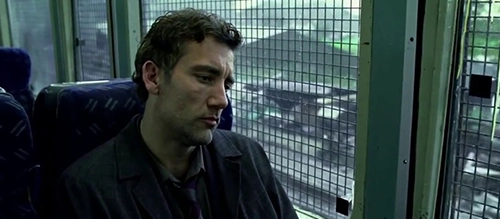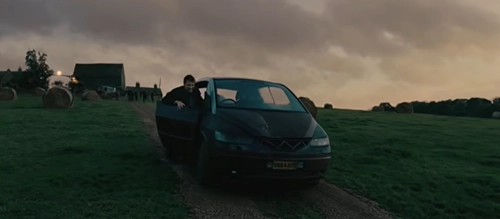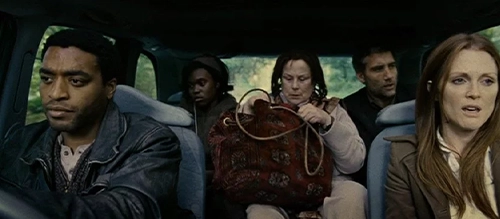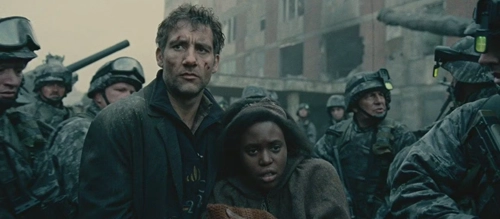Children of Men: Dropping Us Into Crisis
Alfonso Cuarón reimagined how to capture the intensity of war when he crafted his 2006 dystopian masterpiece Children of Men. Set in the not-so-distant future of 2027 London, women have (somehow) become infertile. As a result, humanity is facing extinction, which creates a desperate and caustic environment of morally bankrupt nihilists who see no hope for a future and, thus, have no regard for the sanctity of life.
In the film, disaffected bureaucrat Theo Faron (Clive Owen) is tasked with shepherding the last pregnant woman in the world, Kee (Clare-Hope Ashitey), to a safe haven to escape the calamity. By adopting a hyper-vérité style akin to what Gillo Pontecorvo employed in The Battle of Algiers (1966), Cuarón offers a merciless conviction in his direction, using the documentary-adjacent style to achieve maximum effect.
The film uses its action as a vital point to create friction and heightens it through sequences that apply constant pressure to the characters and each of us. Children of Men creates tension unlike any film of the new millennium by maximising its long takes through composed pacing, definitive choreography, and a hardened realism. By combing all of those efforts, the film leaves a lasting impression and raises the bar on the capabilities of modern filmmaking.

Long takes in the modern age have become something of a gimmick when the director wants to show off their prowess as an artist, and they can often leave you wanting more as they simply buoy through a scene with no real purpose. Children of Men has several long take sequences that are incremented together, but instead of being monotonous and drawn-out they are all-encompassing, kinetic, and well-paced. By spacing out the one-takes, Cuarón makes these moments more palatable for us instead of having it feel like one long slide down to the bottom.
This is perhaps best illustrated when Theo, Kee and Miriam (Pam Ferris) attempt to escape from the Fishes (an anti-fascist resistance group fighting for social liberation) after learning some troubling news. The camera carefully follows Theo at ground level as he leads Kee and Miriam around the compound in the early morning and, despite the natural jitters that come with shooting handheld, is done in smooth and guarded fashion. It never shakes too much for it to be nauseating, nor does it feel sluggish, moving step-for-step no matter how fast or slow. Accompanying that with the ambient sound of dawn, it makes every noise heard (near or far) sound deafening. It’s the sneaking around version of driving the nitro-glycerine trucks from Henri-Georges Clouzot’s The Wages of Fear (1953) – any mishap could be catastrophic, and momentum is crucial.

Pacing a take not only affects the action of the current moment but can also reflect the stylistic tone of an entire film. A couple of examples of rhythmic difference in long-takes from the last few years can be that of Sam Mendes’ British World War 1 epic 1917 (2019) and Romain Gavras’ modern French uprising film Athena (2022). Both effectively use long takes but harness wildly different pacing styles.
1917 is designed to look like one continuous shot (with some small digital edits), and uses a variety of crane and Steadicam shots to take in the scenery of Northern France in World War One. In contrast, Athena is shot frenetically, as the bedlam of every scene is accentuated by a handheld dexterity that hits like a bolt of lightning, as it augments the banlieue (French for “suburb”) Athena to new heights. If the pacing of 1917 is methodical and Athena’s dynamic, Children of Men is able to find the sweet spot of the two more often than not by ramping up and down the action when needed to convey sensitive information. Now, there are times when the camera perhaps lingers longer than it should instead of just simply cross-cutting, but it works to keep tempo stylistically with the rest of the film.
In addition to each of the long takes being well-paced, they are also immaculately designed and choreographed. The blocking that is on display ensures that everything in the frame gets used and there is no dead space being packed into the shot. The scene that highlights this the best is the Canterbury forest ride ambush, which happens relatively early but sets the stage for the onslaught our heroes will be encountering.

It begins innocently enough, with Theo and his ex-wife/resistance leader Julian (Julianne Moore) playing a game of blowing ping pong balls into each other’s mouths and casually flirting, while fellow resistance member Luke (Chiwetel Ejiofor) drives. As they move through the forest, they are swarmed by a group of armed deserters who go on the offensive against our helpless heroes as the camera oscillates inside the vehicle, capturing the madness.
Beginning from Theo’s perspective in the car, and switching and forth during the blitz, the sheer number of people converging on the vehicle is overwhelming and makes a typically open space feel claustrophobic. It’s as though the characters are drowning on dry land, and the mania amps up even more when Julian is shot by chasing motorcyclists. There might be some lingering questions regarding the legitimacy of a small group being able to overwhelm the car so ineffectively, but it does add thematic context to the story of showcasing hope (what little there is) against despair.
But staging and pacing can only be properly utilized if there is truly exceptional camerawork that can create a definitive realism. The camera team behind the film – director Alfonso Cuarón and his long-time friend/collaborator Emmanuel Lubezki – craft a raw and murky modernity that makes the characters and environments feel lived-in, ranging from the bureaucratic and consumer-obsessed metropolis to the confines of a secluded log cabin.
When describing why he wanted to shoot Children of Men in non-fluid long takes, Cuarón stated that it “was to take advantage of the element of real-time.” This harkens back to the documentary-like style mentioned at the top and how each shot, no matter how extreme, provokes a visceral and truthful reaction against an imperial obstacle in a way that is plausible and terrifying. It puts a mental timer on the viewer and makes each subsequent choice more pivotal than the last.
The sequence that features this as a focal point is that of the climatic refugee camp warzone, where Theo has to rescue Kee from the Fishes as they do battle against the British military. This is the point of the film where the battle between these two opposing forces reaches its most hysterical.

As the hand-held camera follows Theo as he traverses this makeshift battlefield in the hope of rescuing Kee, the sequence intoxicates as the descending tanks and constant gunfire capture the tumultuous and bombastic elements of a real-time war unfolding. What makes this long-take so effective is the velocity of the violence that is taking place. The bullets whiz through everything like paper and deal swift death, while the explosions are practical and create a large shock not just in Theo but in each of us too.
A moment that is particularly striking, though brief, is when Theo has to take cover inside a bus as an armoured tank approaches and blood gets on the camera lens. The scene evokes the same deadly speed and emotional stakes as Steven Spielberg’s taking of Omaha Beach in Saving Private Ryan (1998), developing in a way that is both realistic and colossal. The films also share the characteristic of having its lens be muddied with blood and dirt to showcase the magnitude of their skirmishes.
Even though Saving Private Ryan is a brutal depiction of battle and portrait of valor, there are a few moments where the bravado of the soldiers and the spectacle of war as a whole overtake it to the point of it becoming pure entertainment and losing its gravitas. In Children of Men, you get the opposite effect. There is no lionizing of the characters, they are all deeply flawed people who have to claw their way out of every hellish situation, with each scenario becoming more unforgiving and vicious than the last.
Putting it all together, Children of Men cements itself in cinema history as an awe-inspiring tour de force in science fiction action. It puts us squarely into the headspaces of its characters and does so with authenticity and conviction. Fusing that with the brilliance of Cuarón’s direction, it creates visual splendor with each shot and subverts action convention at every turn. It’s nothing short of an emotionally rich film, one that was game-changing when it was released in theatres and remains nothing short of a miracle today.
Written by Mark Serravalle
You can support Mark Serravalle on Twitter: @MarkSerravalle

